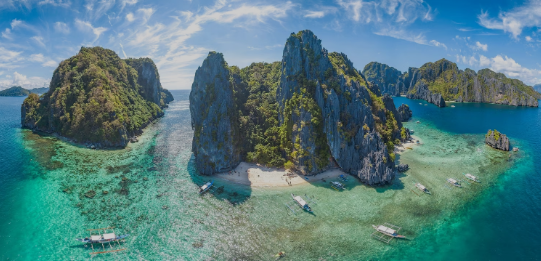The Philippines, an archipelago in Southeast Asia, experiences a tropical climate with three distinct seasons: dry season, wet season, and the typhoon season.

The best time for a vacation depends on your preferences and the activities you plan to engage in. Here’s a detailed description of the different seasons:
Table of Contents
1. Dry Season (November to April):
- Best Time for Travel:
- The dry season, also known as the “Amihan” season, is generally considered the best time for a vacation in the Philippines.
- It starts in November and lasts until April.
- Weather Conditions:
- Clear skies and sunny weather prevail during the dry season.
- Minimal rainfall, making it ideal for outdoor activities, beach trips, and exploring.
- Temperature:
- Average temperatures range from 25°C to 32°C (77°F to 89.6°F).
- Popular Destinations:
- Boracay, Palawan, Cebu, Bohol, and other beach destinations are popular during this time.
- Perfect for water activities like snorkeling, diving, and island hopping.
- Festivals:
- Many local festivals and events, such as Ati-Atihan in Kalibo and Sinulog in Cebu, take place during the dry season.
- Considerations:
- This is the peak tourist season, so popular destinations can be crowded.
- Accommodations and flights may be more expensive, so it’s advisable to book in advance.
2. Wet Season (May to October):
- Best Time for Travel:
- The wet season, or “Habagat” season, occurs from May to October.
- Travel during this period may be less crowded, and prices for accommodations and flights may be lower.
- Weather Conditions:
- Increased rainfall, occasional typhoons, and higher humidity characterize the wet season.
- Rain showers are frequent but usually short-lived, and there are still plenty of sunny days.
- Temperature:
- Average temperatures remain relatively consistent, ranging from 25°C to 32°C (77°F to 89.6°F).
- Popular Destinations:
- While some beach destinations may experience intermittent rain, destinations like Banaue and Batanes are less affected and can be visited during the wet season.
- Rainforests and waterfalls are lush and vibrant during this time.
- Festivals:
- Some festivals, like the Kadayawan Festival in Davao, take place during the wet season.
- Considerations:
- Activities like trekking and exploring waterfalls can be more enjoyable due to the lush landscapes.
- Check weather forecasts and be aware of typhoon warnings.
3. Typhoon Season (July to October):
- Typhoon Risk:
- The Philippines is prone to typhoons, especially from July to October.
- While not all regions are affected, it’s crucial to monitor weather updates and plan accordingly.
- Considerations:
- Travelers should stay informed about potential typhoons and be prepared to adjust plans.
- Coastal and low-lying areas are more susceptible to flooding and storm surges during typhoons.
- Destinations:
- Some areas like Luzon and parts of the Visayas may experience typhoons during this period.
- Precautions:
- Follow local advice, stay in accommodations that meet safety standards, and have contingency plans in case of severe weather.
General Tips:
- Diving:
- The dry season is excellent for diving, offering better underwater visibility.
- Some dive sites may be closed during the wet season due to weather conditions.
- Festivals:
- Check the festival calendar to coincide your visit with local celebrations.
- Festivals showcase the Philippines’ rich cultural heritage and traditions.
- Booking Flights and Accommodations:
- For the dry season, book in advance to secure preferred accommodations and flight options.
- During the wet season, flexibility in travel plans is advisable due to potential weather disruptions.
- Local Holidays:
- Be aware of local holidays and plan accordingly, as some attractions and services may be busier during these times.
In summary, the best time for a Philippines vacation depends on your preferences and the activities you plan to undertake. The dry season is generally recommended for beach destinations and outdoor activities, while the wet season offers lush landscapes and fewer crowds. Always stay informed about weather conditions, especially during the typhoon season.



